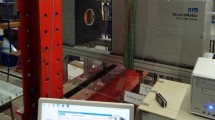Abstract
Stressmeters are gages designed to enable stress changes to be determined without the need to know the elasticity moduli of the body being studied. This paper describes a technique by which the magnitude of the greatest principal stress in a biaxial-stress field can be determined from the isochromatic fringe pattern in a hollow-cylindrical-glass stressmeter. The influence of the moduli and Poisson's ratio of the meter and host material on the sensitivity of the meter are discussed in detail. It is shown that, for a wide range of rock and concrete-like materials, a glass stressmeter will enable the stresses to be determined directly from the meter readings.
Experiments to investigate the behavior of photoelastic stressmeters in host materials which are creeping under stress are described. Results of tests using frozen sand slabs have shown that under uniaxial stress there is little effect of creep on the meter readings until excessive fracturing occurs. There is also close agreement between the theoretical and experimental values for the meter sensitivity when it is assumed that the Poisson's ratio of the host materials falls to 0.5 during creep. When set in such materials the final sensitivity of the meter is also independent of the modulus of the meter provided that creep is continuous.
Experiments are described which show that, in a material which is creeping, the stress can be determined by inserting a stressmeter and measuring the final steady reading.
Similar content being viewed by others
Abbreviations
- a :
-
radius of inclusion
- b :
-
radius of central hole
- E h, Eg :
-
Young's moduli of host material and inclusion, r respectively
- f :
-
photoelastic-material fringe value of inclusion
- k 1, k3 :
-
constants defined in Appendix
- n :
-
isochromatic fringe order (white light) at a point in the inclusion
- p, q :
-
greatest and least principal stresses in the plane of the inclusion;p>q and tensile stresses positive
- P :
-
meter sensitivity factor
- r :
-
radius of any point in inclusion
- t :
-
length of inclusion
- η:
-
ratioq/p
- θ:
-
angular displacement relative to greatest principal stress
- u h, vg :
-
Poisson's ratios of host material and inclusion, respectively
References
Muskhelishvili, N. I., “Some Basic Problems of the Mathematical Theory of Elasticity,”P. NoordhooffLtd., Groningen, Holland (1953).
Roberts, A., Hawkes, I., Williams, F. T., andDhir, R. K., “A Laboratory Study of the Photoelastic Stressmeter,”Int. Jnl. Rock Mech. & Min. Sci.,1,441–457 (1965).
Roberts, A., Hawkes, I., andWilliams, F. T., “Some Field Application of the Photoelastic Stressmeter,”,2,93–103 (1965).
Barron, K., “Glass Insert Stressmeters,”AIME Trans.,232,287–299 (December1965).
Hiramatsu, Y., “Measurement of Variation in Stress with a Photoelastic Stressmeter,” Laboratory of Mining Engineering, Dept. of Mining, Kyoto University (March 1964).
Hawkes, I., andFellerrs, G. E., “Theory of the Determination of the Greatest Principal Stress in Biaxial Stress Fields using Photoelastic Hollow Cylinder Inclusions,”Tech. Note, U.S. Army Cold Regions Res. and Eng. Lab., Hanover, N.HH. (Jan.1968).
Durelli, A. J., Park, V. J., Feng, H. C., and Chiang, F., “Stresses and Strains in Matrices with Inserts,” Contract No. Nonr 2249 (06) C.U.A. Project No. 4.147.05. Clearinghouse No. AD 653 721 (May 1967).
Hawkes, I., “Moduli Measurements on Rock Cores,” 1st Int. Cong. on Rock Mech., Lisbon (Sept. 1966).
Berry, D. C., and Fairhurst, C., “Influence of Rock Anistropy and Time-Dependent Deformation on the Stress Relief and High Modulus Inclusion Techniques of In Situ Stress Determination,” ASTM STP 42 (1966).
Sayles, F. H., “Studies in the Creep of Frozen Soils,”Tech. Report 190, U. S. Army Cold Regions Res. and Eng. Lab., Hanover, N. H. (1967).
Jordan, D. W., “Strains in an Annular Rock Dynamometer,”Jnl. of Strain Anal.,1,1 (1965).
Author information
Authors and Affiliations
Rights and permissions
About this article
Cite this article
Hawkes, I. Stress evaluation in low-modulus and viscoelastic materials using phtoelastic glass inclusions. Experimental Mechanics 9, 58–66 (1969). https://doi.org/10.1007/BF02326675
Issue Date:
DOI: https://doi.org/10.1007/BF02326675




